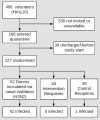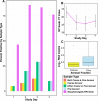Minimal transmission in an influenza A (H3N2) human challenge-transmission model within a controlled exposure environment
- PMID: 32658939
- PMCID: PMC7390452
- DOI: 10.1371/journal.ppat.1008704
Minimal transmission in an influenza A (H3N2) human challenge-transmission model within a controlled exposure environment
Abstract
Uncertainty about the importance of influenza transmission by airborne droplet nuclei generates controversy for infection control. Human challenge-transmission studies have been supported as the most promising approach to fill this knowledge gap. Healthy, seronegative volunteer 'Donors' (n = 52) were randomly selected for intranasal challenge with influenza A/Wisconsin/67/2005 (H3N2). 'Recipients' randomized to Intervention (IR, n = 40) or Control (CR, n = 35) groups were exposed to Donors for four days. IRs wore face shields and hand sanitized frequently to limit large droplet and contact transmission. One transmitted infection was confirmed by serology in a CR, yielding a secondary attack rate of 2.9% among CR, 0% in IR (p = 0.47 for group difference), and 1.3% overall, significantly less than 16% (p<0.001) expected based on a proof-of-concept study secondary attack rate and considering that there were twice as many Donors and days of exposure. The main difference between these studies was mechanical building ventilation in the follow-on study, suggesting a possible role for aerosols.
Conflict of interest statement
I have read the journal's policy and the authors of this manuscript have the following competing interests: JSN-V-T and BK declare previous consultancy fees from H-Vivo plc, unrelated to the current work. JSN-V-T is currently seconded to the Department of Health and Social Care (DHSC), England; the views expressed in this paper are not necessarily those of DHSC. RLW, AG and AM are employees of H-Vivo plc each of whom hold shares and /or share options in the company.
Figures




